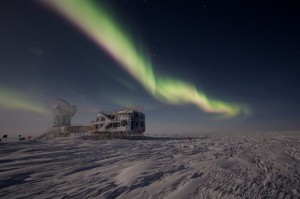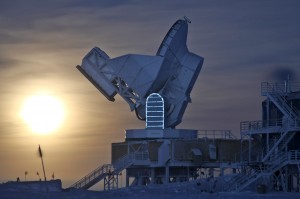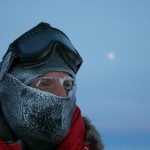
By Pascal Zamprelli
“The sun set back in March,” is not a phrase you hear very often. At least not here in a part of the world where, when the sun sets, you can generally count on it to rise the next morning. Keith Vanderlinde, however, has been stationed at the South Pole since February, and has been plunged into darkness since that sunset. “It certainly makes the work more difficult,” he said.
The work Vanderlinde is referring to represents a major collaboration between nine universities, known as The South Pole Telescope (SPT). It is a massive instrument that consists mainly of a 10-metre primary dish and a camera designed to investigate the cosmic microwave background – invisible to regular cameras – which Vanderlinde describes as “the afterglow of the Big Bang.” As that light comes toward us on Earth, it passes through masses, such as big clusters of galaxies, which create distortions the SPT can detect.
McGill astrophysicist Prof. Matt Dobbs, along with Prof. Gil Holder, has spearheaded McGill’s involvement with the South Pole Telescope, which began to be built in 2003 and saw first light in 2007. “We want to make the most comprehensive catalogues of galaxy clusters that there are,” said Dobbs, “in order to learn how these clusters – and the universe itself – have changed since the beginning of time.”
“We’re primarily interested in how the universe as a whole evolved and what the universe is made up of, so we use the galaxy clusters as tracers for the expansion history of the universe.”

This, in turn, may help solve some of the mysteries surrounding dark energy, which cosmologists discovered about a decade ago. It makes up almost three-quarters of our universe, but we still know very little about it. The evolution of the clusters depends on both gravity and the dark energy pulling them apart. “We already know gravity fairly well,” Vanderlinde said, “so this will tell us a whole lot about the dark energy.”
Until Vanderlinde, who got involved with the project at the University of Chicago, arrives at McGill in the new year to analyze the data, he remains part of the skeleton crew of roughly 60 living at the research station over the austral winter, two of whom work on the SPT.
“There are no average days down here,” he said. “Things can be very quiet, or we could find out that we lost power in the middle of the night, which is what happened two weeks ago. So the whole telescope goes down to ambient temperature, which at the time was minus-65 C.”

Therein lies another challenge. It’s dark, but it’s also very cold. Yet Vanderlinde says “It’s astonishing how well you can adapt to the cold. Like today we’re having a storm and it’s the warmest it’s been since I got here – we’re actually at about minus-35 C – and when I go outside now I overheat!”
And the darkness? No problem. “It’s the furthest thing in the world from depressing, I think, because you get just the most amazing starscape, and constant auroras. The light show overhead is incredible.”
In fact, judging by his photographs, when the sun rises again on Sept. 21, he may wish it had just stayed down.
